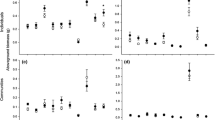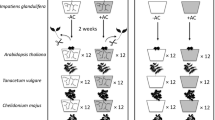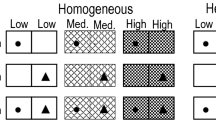Abstract
The last decade has seen spirited debates about how resource availability affect the intensity of competition. This paper examines the effect that a dominant introduced species, Carrichtera annua, has upon the winter annual community in the arid chenopod shrublands of South Australia. Manipulative field experiments were conducted to assess plant community response to changing below-ground resource levels and to the manipulation of the density of C. annua. Changes in the density of C. annua had little effect on the abundance of all other species in the guild. Nutrient addition produced an increase in the biomass of the most abundant native species, Crassula colorata. An analysis of the root distribution of the main species suggested that the areas of soil resource capture of C. annua and C. colorata are largely segregated. Our results suggest that intraspecific competition may be stronger than interspecific competition, controlling the species responses to increased resource availability. The results are consistent with a two-phase resource dynamics systems, with pulses of high resource availability triggering growth, followed by pulses of stress. Smaller plants were nutrient limited under natural field conditions, suggesting that stress experienced during long interpulse phases may override competitive effects after short pulse phases. The observed differences in root system structure will determine when plants of a different species are experiencing a pulse or an interpulse phase. We suggest that the limitations to plant recruitment and growth are the product of a complex interplay between the length and intensity of the pulse of resource availability, the duration and severity of the interpulse periods, and biological characters of the species.
Similar content being viewed by others
References
Berendse F. 1983. Interspecific competition and niche differentiation between Plantago lanceolata and Anthoxanthum odoratum in a natural hay field. Journal of Ecology 71: 379–390.
Belsky A.J. 1992. Effects of trees on nutritional quality of understorey gramineous forage in tropical savannas. Tropical Grasslands 26: 12–20.
Bergelson J. and Perry R. 1989. Interspecific competition between seeds: relative planting date and density affect seedling emergence.Ecology70: 1639–1644.
Callaway R.M., De Lucia E.H., Moore D., Nowak R. and Schlesinger W.H. 1996. Competition and facilitation: contrasting effects of Artemisisa tridentata on desert vs. montane pines.Ecology 77: 2130–2141.
Callaway R.M., Nadkarni N.M. and Mahall B.E. 1991. Facilitation and interference of Quercus douglasii on understory productivity in central California. Ecology 72: 1484–1499.
Chesson P. and Huntly N. 1997. The roles of harsh and fluctuating conditions in the dynamics of ecological communities. American Naturalist 150: 519–553.
Crawley M.J. 1990. The structure of plant communities. In: Crawley M.J. (ed.), Plant Ecology. Blackwell Science, London, pp. 475–531.
Crocker R.L. 1946. An introduction to the soils and vegetation of Eyre Peninsula, South Australia. Transactions of the Royal Society of South Australia 70: 83–105.
Elton C.S. 1958. The Ecology of Invasions by Animals and Plants.Methuen & Co. Ltd., London.
Facelli J.M. and Brock D.R. 2000. Patch dynamics in arid lands: localized effects of Acacia papyrocarpa on soils and vegetation of open woodlands of South Australia. Ecography 23: 479–491.
Facelli J.M. and Temby A.M. Multiple effects of shrubs control the structure of annual plant communities in arid lands of South Australia. Austral Ecology (in press).
Fenner M. 1985. Seed Ecology. Chapman & Hall, London.
Fowler N. 1986. The role of competition in plant communities in arid and semiarid regions. Annual Review of Ecology and Systematics 17: 89–110.
Garner W. and Steinberger Y. 1989. A proposed mechanism for the formation of ?Fertile Islands? in the desert ecosystem. Journal of Arid Environments 16: 257–262.
Goldberg D. and Novoplansky A. 1997. On the relative importance of competition in unproductive environments. Journal of Ecology 85: 409–418.
Goldberg D.E. and Miller T.E. 1990. Effects of different resource additions on species diversity in an annual plant community.Ecology 71: 213–225.
Goldberg D.E. and Werner P.A. 1983. Equivalence of competitors in plant communities: A null hypothesis and a field experimental approach. American Journal of Botany 70: 1098–1104.
Grime J.P. 1973. Competitive exclusion in herbaceous vegetation. Nature 242: 344–347.
Grime J.P. 1979. Plant Strategies and Vegetation Processes. John Wiley & Son, New York.
Grime J.P. and Curtis A.V. 1976. The interaction of drought and mineral nutrient stress in calcareous grasslands. Journal of Ecology 64: 975–988.
Grime J.P. and Hodgson J.G. 1987. Botanical contributions to contemporary ecological theory. New Phytologist 106: 283–295.
Gutierrez J.R., Meserve P.L., Contreras L.C., Vasquez H. and Jaksic F.M. 1993. Spatial distribution of soil nutrients and ephemeral plants underneath and outside the canopy of Porlieria chilensis shrubs (Zygophyllaceae) in arid coastal Chile. Oecologia 95: 347–352.
Gutterman Y. 1989. Carrichtera annua. In: Halevy A.H. (ed.), CRC Handbook of Flowering. Vol. VI. CRC Press, Boca Raton, FL, USA, pp. 157–161.
Gutterman Y. 1993. Seed Germination in Desert Plants. Springer-Verlag, Berlin.
Harper J.L. 1977. Population Biology of Plants. Academic Press, London.
Inouye R.S. 1980. Density-dependent germination response by seeds of desert annuals. Oecologia 46: 235–238.
Jacobs J.S. and Sheley R.L. 1999. Competition and niche partitioning among Pseudoroegneria spicata, Hedysarum boreale, and Centaurea maculosa. Great Basin Naturalist 59: 175–181.
Jessop J.P. and Toelken H.R. 1986. Flora of South Australia. 2nd edn. South Australia Goverment Publishing Division, Adelaide.
Loira M. and Noy-Meir I. 1979. Dynamics of some annual populations in a desert loess plain. Israel Journal of Botany 28: 211–225.
Ludwig J.A. and Tongway D.J. 1995. Spatial organisation of landscapes and its function in semi-arid woodlands, Australia.Landscape Ecology 10: 51–63.
Ludwig J.A. and Tongway D.J. 1997. A landscape approach to rangeland ecology. In: Ludwig J., Tongway D., Freudenberg D., Noble J. and Hodkinson K. (eds), Landscape Ecology, Function and Management: Principles for Australia's Rangelands.CSIRO Publishing, Canberra, pp. 1–12.
Mahdi A., Law R. and Willis A.J. 1989. Large niche overlaps among coexisting plant species in a limestone grassland community.Journal of Ecology 77: 386–400.
Mahmoud A. and Grime J.P. 1976. An analysis of competitive ability in three perennial grasses. New Phytologist 77: 431–435.
Maranon T. and Bartolome J.W. 1993. Reciprocal transplants of herbaceous communities between Quercus agrifolia woodland and adjacent grassland. The Journal of Ecology 81: 673–682.
Marschner H. 1995. Mineral Nutrition of Higher Plants. Academic Press, London.
Newman E.I. 1973. Competition and diversity in herbaceous vegetation.Nature 244: 310.
Noy-Meir I. 1973. Desert ecosystems: environment and producers.Annual Review of Ecology and Systematics 4: 25–51.
Parker V.T. and Muller C.H. 1982. Vegetation and environmental changes beneath isolated live oak trees (Quercus agrifolia) in a California annual grasslnad. American Midland Naturalist 107: 69–81.
Romney E.M., Wallace A. and Hunter R.B. 1978. Plant response to nitrogen fertilisation in the northern Mohave Desert and its relationship to water manipulation. In: West N.E. and Skujins J.J. (eds), Nitrogen in Desert Ecosystems. Dowden, Hutchinson & Ross Inc., Stroudsburg, Pennsylvania, USA, pp. 232–243.
Ross M.A. and Harper J.L. 1972. Occupation of biological space during seedling establishment. Journal of Ecology 60: 77–88.
Sala O., Golluscio R.A., Lavenroth W.K. and Soriano A. 1989. Resource partitioning between shrubs and grasses in the patagonian steppe. Oecologia 81: 501–505.
Shannon C.E. 1948. A mathematical theory of communication. Bell System Technical Journal 27: 379–423.
Tilman D. 1980. Resources: a graphical mechanistic approach to competition and predation. American Naturalist 116: 362–393.
Tilman D. 1982. Resource Competition and Community Structure.Princeton University Press, Princeton, New Jersey, USA.
Tilman D. 1990. Mechanisms of plant competition for nutrients: the elements of a predictive theory of competition. In: Grace J.B. and Tilman D. (eds), Perspectives on Plant Competition.Academic Press Inc., San Diego, California, USA, pp. 117–142.
Welden C.W. and Slausen W.L. 1986. The intensity of competition versus its importance: an overlooked distinction and some implications.The Quarterly Review of Biology 61: 23–44.
Wilson J.B. 1988. Shoot competition and root competition. Journal of Applied Ecology 25: 279–296.
Wilson S.D. and Tilman D. 1993. Plant competition and resource availability in response to disturbance and fertilisation. Ecology 74: 599–611.
Yeaton R.I. and Cody M.L. 1976. Competition and spacing in plant communities: the northern Mohave desert. Journal of Ecology 64: 689–696.
Yeaton R.I., Travis J. and Gilinsky E. 1977. Competition and spacing in plant communities: the Arizona upland association. Journal of Ecology 65: 587–595.
Author information
Authors and Affiliations
Rights and permissions
About this article
Cite this article
Harris, M.R., Facelli, J.M. Competition and resource availability in an annual plant community dominated by an invasive species, Carrichtera annua (L. Aschers.), in South Australia. Plant Ecology 167, 19–29 (2003). https://doi.org/10.1023/A:1023981500007
Issue Date:
DOI: https://doi.org/10.1023/A:1023981500007




